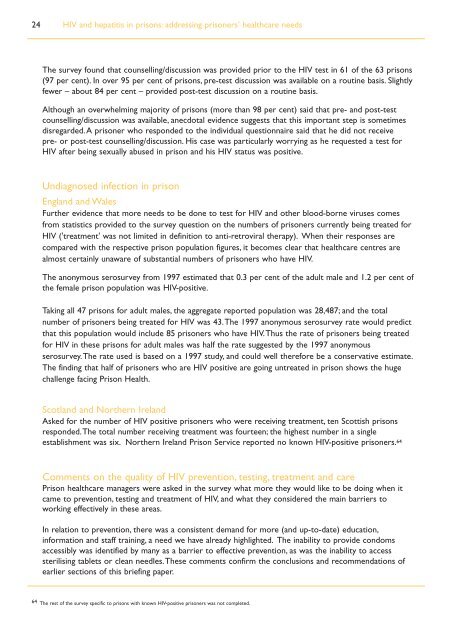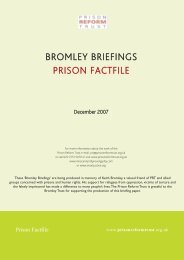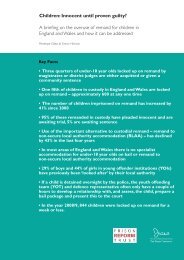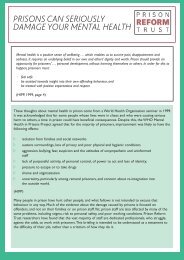HIV and Hepatitis in UK Prisons - Prison Reform Trust
HIV and Hepatitis in UK Prisons - Prison Reform Trust
HIV and Hepatitis in UK Prisons - Prison Reform Trust
Create successful ePaper yourself
Turn your PDF publications into a flip-book with our unique Google optimized e-Paper software.
24 <strong>HIV</strong> <strong>and</strong> hepatitis <strong>in</strong> prisons: address<strong>in</strong>g prisoners’ healthcare needs<br />
The survey found that counsell<strong>in</strong>g/discussion was provided prior to the <strong>HIV</strong> test <strong>in</strong> 61 of the 63 prisons<br />
(97 per cent). In over 95 per cent of prisons, pre-test discussion was available on a rout<strong>in</strong>e basis. Slightly<br />
fewer – about 84 per cent – provided post-test discussion on a rout<strong>in</strong>e basis.<br />
Although an overwhelm<strong>in</strong>g majority of prisons (more than 98 per cent) said that pre- <strong>and</strong> post-test<br />
counsell<strong>in</strong>g/discussion was available, anecdotal evidence suggests that this important step is sometimes<br />
disregarded.A prisoner who responded to the <strong>in</strong>dividual questionnaire said that he did not receive<br />
pre- or post-test counsell<strong>in</strong>g/discussion. His case was particularly worry<strong>in</strong>g as he requested a test for<br />
<strong>HIV</strong> after be<strong>in</strong>g sexually abused <strong>in</strong> prison <strong>and</strong> his <strong>HIV</strong> status was positive.<br />
Undiagnosed <strong>in</strong>fection <strong>in</strong> prison<br />
Engl<strong>and</strong> <strong>and</strong> Wales<br />
Further evidence that more needs to be done to test for <strong>HIV</strong> <strong>and</strong> other blood-borne viruses comes<br />
from statistics provided to the survey question on the numbers of prisoners currently be<strong>in</strong>g treated for<br />
<strong>HIV</strong> ('treatment' was not limited <strong>in</strong> def<strong>in</strong>ition to anti-retroviral therapy). When their responses are<br />
compared with the respective prison population figures, it becomes clear that healthcare centres are<br />
almost certa<strong>in</strong>ly unaware of substantial numbers of prisoners who have <strong>HIV</strong>.<br />
The anonymous serosurvey from 1997 estimated that 0.3 per cent of the adult male <strong>and</strong> 1.2 per cent of<br />
the female prison population was <strong>HIV</strong>-positive.<br />
Tak<strong>in</strong>g all 47 prisons for adult males, the aggregate reported population was 28,487; <strong>and</strong> the total<br />
number of prisoners be<strong>in</strong>g treated for <strong>HIV</strong> was 43.The 1997 anonymous serosurvey rate would predict<br />
that this population would <strong>in</strong>clude 85 prisoners who have <strong>HIV</strong>.Thus the rate of prisoners be<strong>in</strong>g treated<br />
for <strong>HIV</strong> <strong>in</strong> these prisons for adult males was half the rate suggested by the 1997 anonymous<br />
serosurvey.The rate used is based on a 1997 study, <strong>and</strong> could well therefore be a conservative estimate.<br />
The f<strong>in</strong>d<strong>in</strong>g that half of prisoners who are <strong>HIV</strong> positive are go<strong>in</strong>g untreated <strong>in</strong> prison shows the huge<br />
challenge fac<strong>in</strong>g <strong>Prison</strong> Health.<br />
Scotl<strong>and</strong> <strong>and</strong> Northern Irel<strong>and</strong><br />
Asked for the number of <strong>HIV</strong> positive prisoners who were receiv<strong>in</strong>g treatment, ten Scottish prisons<br />
responded.The total number receiv<strong>in</strong>g treatment was fourteen; the highest number <strong>in</strong> a s<strong>in</strong>gle<br />
establishment was six. Northern Irel<strong>and</strong> <strong>Prison</strong> Service reported no known <strong>HIV</strong>-positive prisoners. 64<br />
Comments on the quality of <strong>HIV</strong> prevention, test<strong>in</strong>g, treatment <strong>and</strong> care<br />
<strong>Prison</strong> healthcare managers were asked <strong>in</strong> the survey what more they would like to be do<strong>in</strong>g when it<br />
came to prevention, test<strong>in</strong>g <strong>and</strong> treatment of <strong>HIV</strong>, <strong>and</strong> what they considered the ma<strong>in</strong> barriers to<br />
work<strong>in</strong>g effectively <strong>in</strong> these areas.<br />
In relation to prevention, there was a consistent dem<strong>and</strong> for more (<strong>and</strong> up-to-date) education,<br />
<strong>in</strong>formation <strong>and</strong> staff tra<strong>in</strong><strong>in</strong>g, a need we have already highlighted. The <strong>in</strong>ability to provide condoms<br />
accessibly was identified by many as a barrier to effective prevention, as was the <strong>in</strong>ability to access<br />
sterilis<strong>in</strong>g tablets or clean needles.These comments confirm the conclusions <strong>and</strong> recommendations of<br />
earlier sections of this brief<strong>in</strong>g paper.<br />
64 The rest of the survey specific to prisons with known <strong>HIV</strong>-positive prisoners was not completed.

















